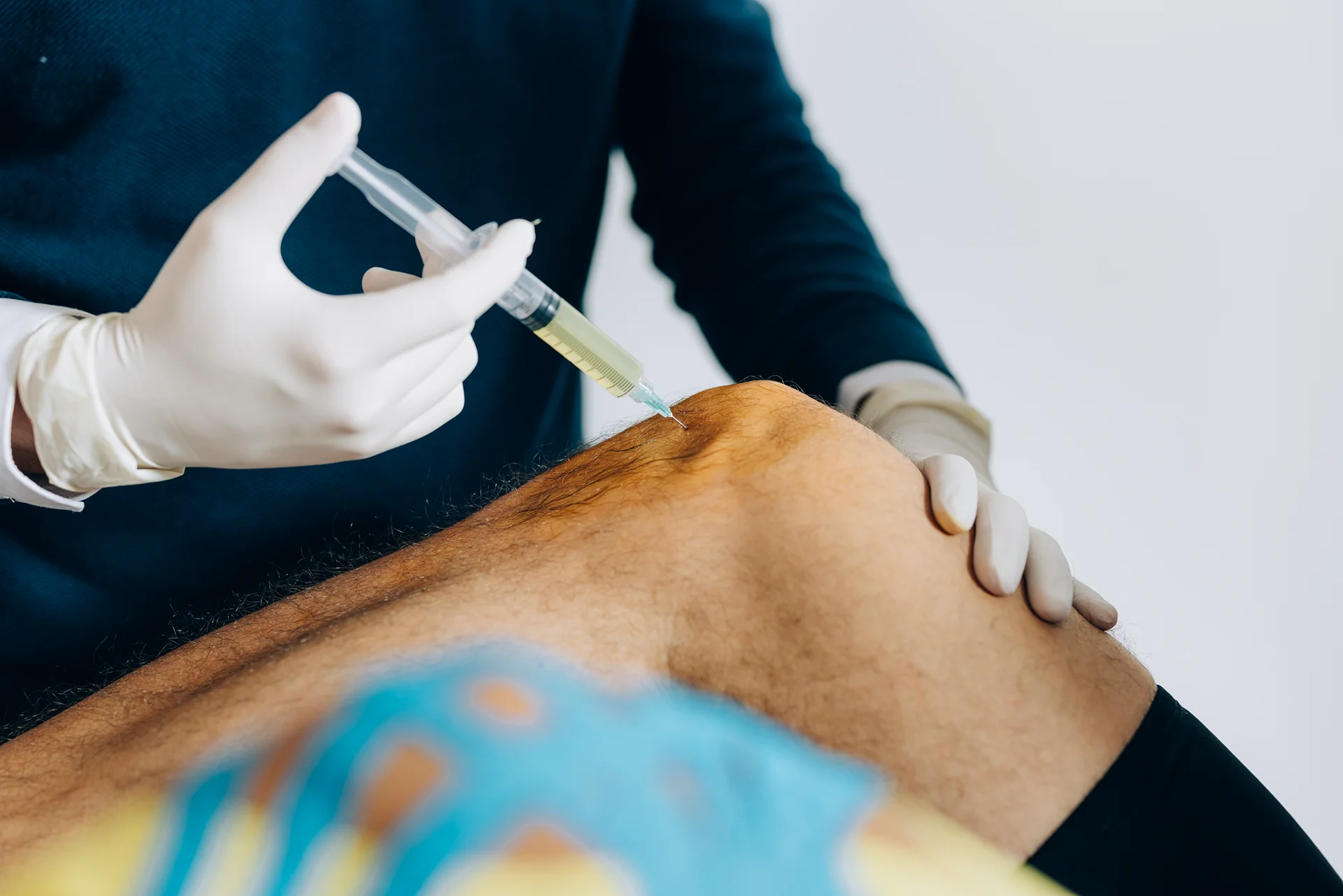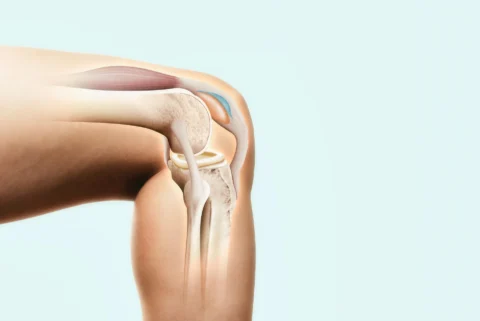Stem cell therapy is emerging as a promising alternative to invasive knee replacement surgery for treating arthritis and cartilage damage.
Knee osteoarthritis is a common and painful condition that develops when the cartilage cushioning the bones in the knee joint gradually wears away. As the disease progresses, bone rubs against bone, causing pain, stiffness, swelling and decreased mobility.
While knee replacement surgery has long been the go-to treatment for advanced osteoarthritis, regenerative medicine approaches like stem cell therapy are offering new hope for repairing joint damage and relieving symptoms without invasive surgery.
What is Stem Cell Therapy for Knees?
Stem cell therapy is a regenerative treatment that involves taking stem cells from a patient’s own body (or a donor) and injecting them into the damaged knee joint. The goal is for these immature cells to develop into new, healthy cartilage and bone tissue to replace what has been lost to injury or arthritis.
The most common type of stem cells used are mesenchymal stem cells, which are found in bone marrow, fat tissue, and blood. These cells have the unique ability to differentiate into cartilage, bone, muscle, and other types of cells needed for tissue repair. When injected into an arthritic knee, stem cells may:
- Develop into new cartilage cells to resurface the ends of the bones
- Suppress inflammation that can break down cartilage
- Release proteins called cytokines that slow cartilage degeneration
- Inhibit scar tissue formation
- Stimulate new blood supply to improve circulation in the joint
Is Stem Cell Therapy Better Than Knee Replacement?
Stem cell therapy is considered a safer and less invasive alternative to knee replacement surgery. It involves injecting a patient’s own stem cells into the knee joint to promote the regeneration of damaged tissue, potentially leading to lasting pain relief and restored joint function.
Unlike knee replacement, which involves replacing the damaged joint with an artificial one, stem cell therapy taps into the body’s natural healing abilities and carries a lower risk of complications such as allergic reactions, infection, or rejection of the regenerated tissue. Additionally, stem cell therapy typically requires only local anesthesia and little to no downtime, whereas knee replacement is a major surgery with a longer recovery period.
However, the effectiveness of stem cell therapy is still being studied, and it may not be suitable for all patients, particularly those with severe knee damage where knee replacement might provide more significant pain relief and improved mobility.
Best to consult with a healthcare professional to determine the best treatment option based on individual needs.
How Does the Stem Cell Procedure Work?
A typical stem cell procedure for knee arthritis involves several steps:
- Harvesting the stem cells – Stem cells are collected from the patient’s own bone marrow (usually from the hip), fat tissue (from the abdomen), or blood. The sample is then processed in a lab to concentrate the stem cells.
- Preparing the knee – The doctor numbs the knee with a local anesthetic and may use an ultrasound or x-ray to visualize the injection site.
- Injecting the stem cells – Using a needle, the doctor injects the stem cells into the knee joint. The cells then migrate to the areas of injury or damage and begin the repair process.
- Recovery – Patients can usually return home the same day. The doctor may recommend rest, physical therapy, and pain medication to aid recovery. Improvement in pain and function may be seen in a matter of weeks or months.
What Is the Success Rate of Stem Cell Therapy for Knees?
Early studies suggest that stem cell therapy has a success rate ranging from 70-80% for treating mild to moderate knee osteoarthritis. Patients often report improvements in pain and function following the treatment.
However, it is important to note that stem cell therapy is a relatively new field, and more research is needed to fully understand its long-term success rate and potential benefits. Additionally, the success of the therapy may vary depending on the individual’s specific condition and the severity of their knee problems.
Stem Cell Therapy vs. Knee Replacement: Weighing the Pros and Cons
For patients with severe osteoarthritis who are considering knee replacement surgery, stem cell therapy may offer an appealing alternative. Compared to traditional joint replacement, stem cell treatment is:
- Less invasive – It can be done as an outpatient procedure and does not require surgical incisions or removal of bone.
- Lower risk – Stem cell therapy carries fewer risks of complications like infection, blood clots, and nerve damage.
- Quicker recovery – Patients may return to normal activities within weeks rather than months.
- Joint sparing – Stem cells may help preserve the natural knee joint and avoid the need for an artificial implant.
- Repeatable – Unlike a joint replacement that can wear out over time, stem cell treatments can be repeated if needed.
However, stem cell therapy is not right for everyone. Ideal candidates have mild to moderate osteoarthritis and sufficient healthy bone and cartilage remaining. For patients with severe joint damage and deformity, knee replacement may be more appropriate.
Additionally, while stem cell treatment may delay or prevent the need for knee replacement in some patients, research is still limited on its long-term effectiveness. More studies are needed to determine optimal cell sources, processing methods, and treatment protocols.
How Long Does Stem Cell Therapy Last for Knees?
The duration of the effectiveness of stem cell therapy for knees can vary. The process of knee tissue repair after stem cell therapy can take two to three months, and patients often experience improved pain and function during this period.
However, there is limited specific information on the long-term duration of stem cell therapy’s effectiveness. In contrast, knee replacements typically last between 10 and 20 years, and patients may require a second procedure if the artificial knee wears out. It is important for patients to have realistic expectations and to discuss the potential longevity of stem cell therapy with their healthcare provider.
Other Regenerative Options for Knee Arthritis
Besides stem cells, other regenerative therapies are being explored for treating knee osteoarthritis and injuries:
Platelet-rich plasma (PRP) – PRP involves collecting a patient’s own blood, concentrating the platelets, and injecting them into the knee. Platelets contain growth factors that may stimulate healing.
Amniotic fluid – This fluid surrounds a developing fetus and contains stem cells and growth factors that may promote tissue repair when injected.
Bone marrow aspirate concentrate (BMAC) – Bone marrow is collected from the patient, processed to concentrate the stem cells, and injected into the knee.
Like stem cell therapy, these treatments aim to enhance the body’s natural healing capacity and slow joint degeneration. They may be used alone or in combination with other therapies.
The Bottom Line
For patients living with knee pain and functional limitations from osteoarthritis, stem cell therapy represents a promising alternative to surgery. By harnessing the body’s own regenerative abilities, this minimally invasive treatment may help repair damaged cartilage, reduce inflammation, and improve joint function.
Note that stem cell treatment is not a magic bullet for knee arthritis. It may not be covered by insurance, and long-term outcomes are still being researched. Patients should talk with an orthopedic specialist to determine if stem cell therapy is right for their individual needs and goals.
As regenerative medicine advances, stem cells and other biologic therapies may increasingly offer new options for restoring damaged joints and enhancing quality of life. With continued research, the future of knee arthritis treatment is looking brighter than ever.
FAQ on Stem Cell Therapy Instead of Knee Replacement
Is Stem Cell Therapy Better Than Surgery?
Stem cell therapy may offer advantages over surgery for certain patients, particularly those with early-stage knee problems or those seeking a less invasive treatment option. It can provide faster recovery times, reduced risks, and the potential to avoid the long-term consequences associated with surgery, such as the need for revision surgery.
However, the comparative effectiveness of stem cell therapy versus surgery is still under investigation, and there is no definitive evidence that stem cell therapy is superior to surgery in all cases. The choice between stem cell therapy and surgery should be personalized, taking into account the patient’s unique needs and the severity of their knee condition.
Can Stem Cells Regrow Knee Cartilage?
Stem cells have the potential to differentiate into specialized cells, including cartilage cells, which can facilitate the regeneration and repair of damaged tissue. There is evidence to suggest that stem cell therapy can lead to the development of new cartilage in the knee joint, potentially repairing affected tissue and decreasing inflammation.
But the extent to which stem cells can regrow knee cartilage is still being researched, and more studies are needed to confirm the efficacy of stem cell therapy in cartilage regeneration.
Number of Injections Needed for Stem Cell Therapy
The number of stem cell injections required for knee therapy can vary depending on the patient and the severity of their condition. For sports injuries, one or two injections may suffice, while patients with osteoarthritis might need periodic injections for continued relief. The results from stem cell injections can last for many years, potentially providing long-lasting relief without the need for surgery.
In some cases, a single stem cell injection may alleviate most discomfort, but a second injection or a PRP injection might be necessary 2-3 months after the initial treatment. Most patients only need one stem cell therapy to see results, with improvements in pain and flexibility often noticed within a few weeks, and the stem cells continue to work over the next year.
Avoiding Knee Replacement Surgery
Stem cell therapy offers a potential alternative to knee replacement surgery for some patients. It utilizes the body’s natural healing mechanisms to treat various conditions, including degenerative diseases of the knee.
Patients who wish to improve their quality of life while avoiding the complications associated with invasive surgical procedures may consider stem cell therapy as an option. The therapy is generally considered safe with minimal complications. Consult with a specialist to determine if stem cell injections are a suitable treatment option.
Candidates Not Suitable for Stem Cell Therapy
Not everyone is a candidate for stem cell therapy. Patients over the age of 60 may have fewer stem cells per unit of volume in their bone marrow, although fat-derived stem cells do not show such loss with aging.
Tobacco use is known to delay healing and increase the risk of infection, so abstinence from all tobacco products is imperative for an optimal response to treatment. Individuals with certain medical conditions or those who have unrealistic expectations about the outcomes of stem cell therapy may not be suitable candidates.











